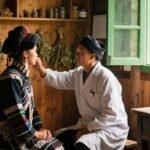Gasha (Boil)
Overview
In Miao-medicine, a boil is called Gasha. It begins as a localized, raised, red, swollen, hot, and painful nodule. The lesion rapidly spreads to surrounding tissue, intensifying pain and forming honeycomb‑like pustular cavities. In the suppurative phase, the infected tissue quickly enlarges and necroses, sometimes accompanied by fever. After about one week, the lesion matures into an abscess with severe pain and persistent high fever. Once the abscess ruptures, symptoms subside and the healing phase begins.
In Traditional Chinese Medicine, a boil (dian chuang) is an acute purulent condition characterized by rapid onset of firm, sore papules topped by millet‑sized pustules, often described as “nail‑head” boils.
Western medicine classifies boils as acute purulent skin infections, presenting with painful erythema that spreads, intense pain, and formation of honeycomb‑like pustules.
Miao-Medicine Classification
Boil is considered a “minor disorder.”
Etiology
Poor hygiene, exposure to wind, dampness, heat toxins, and filth invade the skin and cause infection.
Pathogenesis
Externally, wind‑borne and heat‑borne toxins enter through pores and infect the skin, binding with qi and blood. Internally, weakened defensive qi allows pus formation and lesion development.
Key Diagnostic Feature
Painful, rapidly spreading, red‑swollen nodules with honeycomb‑like pustules are diagnostic of a boil.

Differential Diagnosis
She Chuan Chuang ( Herpes zoster)
Caused by wind‑heat toxins entering the blood, erupting along a dermatome in a serpent‑like pattern of vesicles—often symmetrical.
Dix Cet Ves ( Acne)
Acne presents as small papules or pustules on the face of young adults; lesions vary in duration and do not form deep honeycomb cavities.
Treatment by Stage
1. Early Stage
Signs: Raised, red, swollen, hot, painful lesion spreading rapidly with honeycomb pustules.
Principles: Clear heat and toxins; invigorate blood and resolve stasis.
Herbal Formula (decoct in water):
Actions:
long dan cao: clears heat, dries dampness, drains liver fire, detoxifies
pu gong ying / zi hua di ding: cold herbs that clear heat, detoxify, reduce swelling
xia ku cao: clears heat, dissipates nodules
mu mei rong: warms, clears heat, cools blood, promotes tissue regeneration
Gentianae Radix (long dan cao) 20 g
Taraxaci Herba (pu gong ying) 20 g
Violae Herba (zi hua di ding) 20 g
Prunellae Spica (xia ku cao) 20 g
Hibisci Flower (mu mei rong) 15 g
2. Suppurative Stage
Signs: Rapid expansion and necrosis of tissue, high fever, chills, headache, nausea, thirst.
Principles: Clear heat and toxins; resolve nodules and relieve pain.
Herbal Formula (decoct in water):
Actions:
da qing mu: clears heat, drains dampness, cools blood, detoxifies
zi hua di ding / pu gong ying / ye ju hua: clear heat, resolve toxicity, disperse nodules, relieve pain
bai ma gu: dispels wind and dampness
jin yin hua / qian li guang: clear heat and toxins
Daqingmu (da qing mu) 20 g
Zi hua di ding (zi hua di ding) 20 g
Wild chrysanthemum (ye ju hua) 20 g
Pu gong ying (pu gong ying) 20 g
Baimagu (bai ma gu) 15 g
Lonicera Flower (jin yin hua) 20 g
Centipeda (qian li guang) 20 g
3. Recovery Stage
Signs: About one week after abscess rupture; pain and fever subside as healing begins.
Principles: Tonify qi and blood; harmonize qi and support healing.
Herbal Formula (decoct in water):
Actions:
yang que hua gen: tonifies qi and nourishes yin
fu ling: drains dampness, supports spleen
dang shen: tonifies middle burner qi
shan yao: strengthens spleen, generates fluids, benefits lungs
Mirabilis jalapa root (yang que hua gen) 20 g
Poria (fu ling) 15 g
Codonopsis (dang shen) 15 g
Chinese yam (shan yao) 10 g
Preventive Care
Maintain strict hygiene and isolate lesions. Discard soiled dressings by burning; disinfect changing tools thoroughly.
Educate patients to avoid walking barefoot and to practice good skin care to (helps maintain) new lesions.
Commentary
Boils in Miao medicine arise from combined internal weakness and external invasion of wind, dampness, heat toxins, and filth. Treatment follows a staged approach: early phase focuses on clearing heat and detoxifying; suppurative phase adds nodule resolution and pain relief; recovery emphasizes qi‑blood tonification and qi regulation. Good hygiene and lifestyle measures help (helps maintain) recurrence.



Leave a Reply